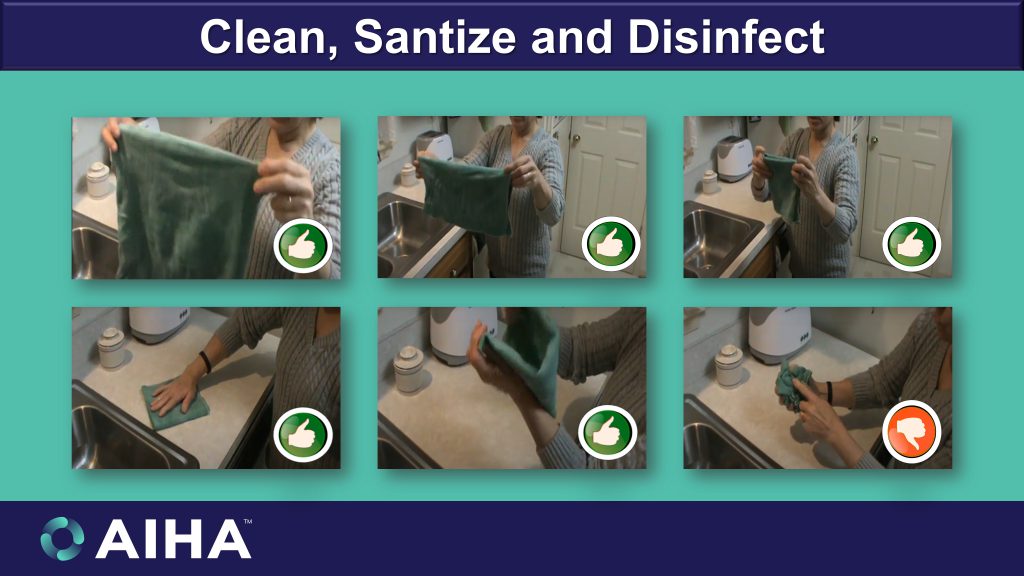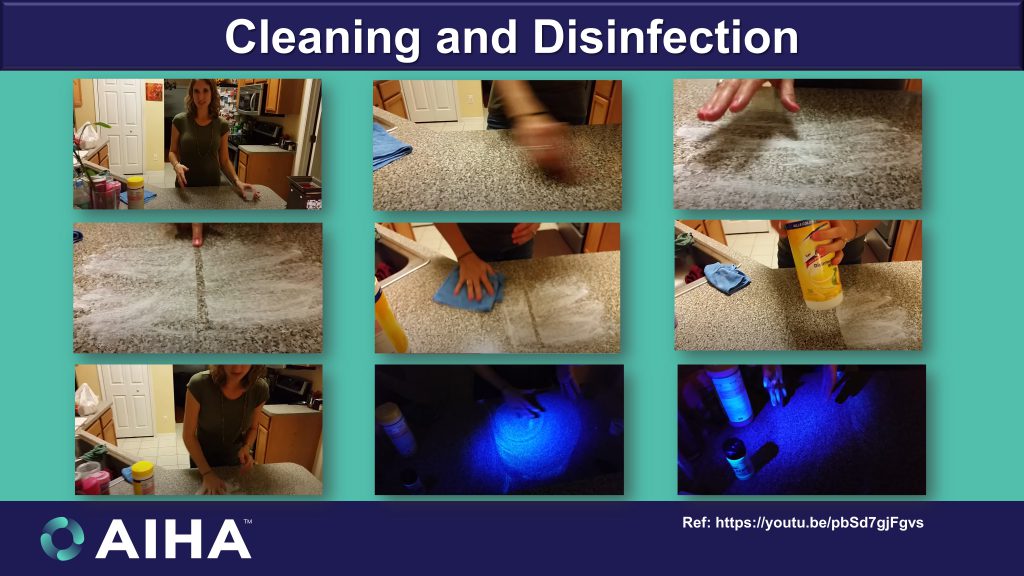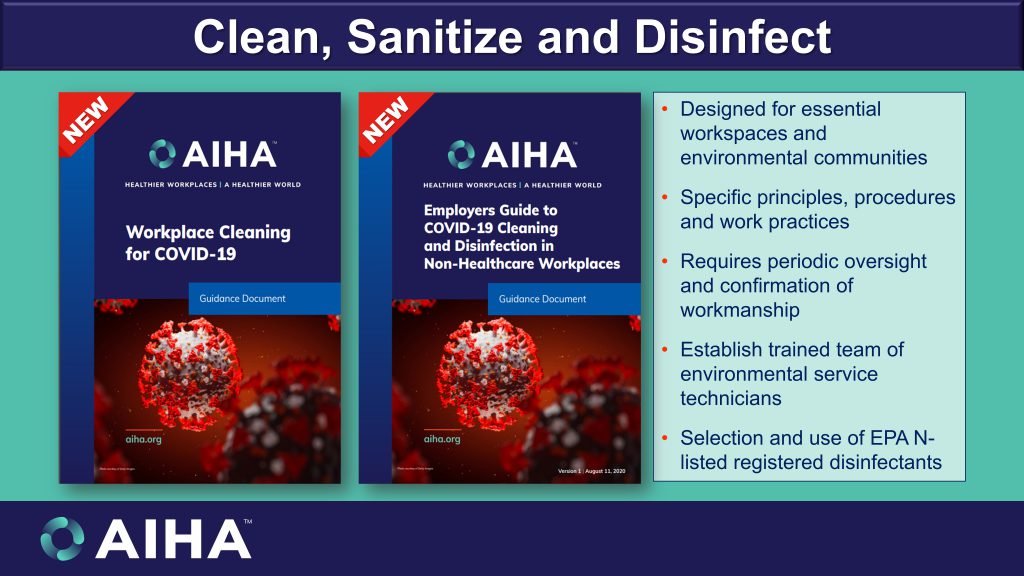Best Practices to Clean, Sanitize & Disinfect the Workplace
Bernard L. Fontaine, Jr., CIH, CSP, FAIHA, Contributor
With the current COVID-19 pandemic, there has been an even greater urgency to keep industrial workspaces, schools, public spaces and commercial facilities clean. While a clean workspace can help reduce the risk of contracting the SARS CoV-2 virus, people need to understand that wiping a surface clean and/or spraying a chemical after wiping the surface is not always going to do the trick. It is a bit more scientific than traditional custodial or janitorial services—but far less complicated than infection control in a hospital.
Best practices for infection control can be used in medical clinics, office buildings, banks, restaurants, government facilities, schools, libraries, museums, bowling alleys, theaters, cruise ships, prisons, municipalities, essential/nonessential businesses, and other facilities or locations where workers or public come into contact with contaminated touched surfaces. The same techniques should be used to clean, sanitize and disinfect high-density work occupancies, such as fisheries, canneries, meat packers, agricultural fields and migrant living quarters; assisted living facilities; emergency medical services; conference rooms; and public transportation (buses, trains, ferry boats, etc.).
Cleaning Dos & Don’ts
Cleaning is a process to remove germs, dirt and impurities from building surfaces or touched objects. Cleaning works by scrubbing, washing and rinsing using soap (or detergent) and warm water to physically remove debris, along with any residual fats and oils (grease). This process does not necessarily kill germs; rather, it removes most of the gross surface contamination that prevents sanitizers and disinfectants from doing their jobs.
Most people use products like paper towels, commercial towelettes or reusable cloths to wipe the surface. Studies show that using a microfiber cloth, rather than other cleaning products, provides better cleaning efficiency. This is because dirt, grease and grim are able to cling better to the microfiber cloth. Using a black light and uncooked chicken, demonstrations show that residual bacteria was left behind on the countertop after using a commercial towelette and paper towel, but the surface was clean with the microfiber cloth.
These products failed to pick up the surface residue left behind during the cleaning process. The black light clearly showed how the smeared surface was left unknowingly contaminated, whereas the surface with the microfiber cloth was visibly clean.
Microfiber cloths, like any other cleaning product, must be laundered periodically for cleaning efficiency. The cloth must be folded into quarters; one should wipe in a structured pattern (up and down then horizontal); and the cloth surface should be rotated periodically to remove any surface grease, grime or grit .Wiping in a circular pattern is not effective.
Figure 1 Caption: Proper procedure for wiping high contact surface with microfiber cloth. (photo source AIHA)
Figure 2 Caption: Comparison between microfiber cloths and commercially available towelettes (photo source AIHA)
Sanitize and Disinfect
Sanitizing helps lowers the number of germs (bacteria) on surfaces or objects to a safer level, as determined by public health standards and requirements. Sanitizers should be used only after effectively cleaning a high-touched surface. These chemicals and commercial products do not kill all organisms. Disinfectants are the only commercial and industrial products that are registered to kill or inactivate viruses by U.S. Environmental Protection Agency (USEPA).1
Countertops and other high-touch points also should be sanitized twice a day. A multi-purpose cleaner can help kill germs in work areas. Sanitizer can be used in common areas where it’s difficult to always keep surfaces and technology clean. The CDC recommends using an alcohol-based sanitizer with at least 60% percent alcohol. Make sure facilities are stocked with plenty of hand soap in the breakroom and bathrooms. Different areas, including office furniture and various surfaces, require different types of cleaning products.
Disinfecting kills or inactivates germs (both bacteria and viruses) on touched surfaces or objects. Disinfecting works by using chemicals to kill germs on surfaces or objects. This process does not necessarily clean dirty surfaces or remove germs, but by killing germs on a surface after cleaning, it can further lower the risk of spreading infection. If disinfectants on this list are in short supply, alternative disinfectants can be used (for example, 1/3 cup of 5.25-8.25% bleach added to 1 gallon of water; or 70% alcohol solutions). Bleach solutions will be effective for disinfection up to 24-hours.2
Besides ethyl and methyl alcohol, other disinfectants include chlorine and chlorine-based compounds, formaldehyde and glutaraldehyde, hydrogen peroxide, iodophors, ortho-phthalaldehyde, peracetic acid (with and without hydrogen peroxide), phenolics and quaternary ammonia.3
Fogging, Vaporizing and Other Risky Methods
Beside wiping surfaces, contractors are using other application methods, like fogging, airless and electrostatic spraying, vaporizing and ionization, to cover large areas in commercial buildings, public transportation, bars and restaurants, and other public spaces. While the USEPA and chemical manufacturers restrict the use and application of certain pesticides, there are contractors that do it anyway. Most of these contractors fail to realize the potential occupational hazard to the applicators and the workforce and/or public that may reoccupy the space.
A small percentage of workers and people who are asthmatics, migraine sufferers have allergies, or those with immune disorders or suppressed immune systems may experience symptoms such as memory loss, trouble concentrating, mood swings, irritability, headaches, seizures, nausea and vomiting without proper building ventilation, airflow and distribution of air throughout the build environment. Many of the chemicals used evaporate quickly. The evaporation also may impede the necessary dwell time the chemical needs to contact the surface to sanitize or disinfect. Chemicals used to sanitize and disinfect need the appropriate dwell time to work. Otherwise, the surface may remain contaminated with the SARS CoV-2 virus.
Figure 3 Caption: A worker sprays disinfectant inside a Delta airplane at the Ronald Reagan Washington National Airport in Arlington, Va., between flights to kill any coronavirus left on surfaces. (photo courtesy Nathan Ellgren/Associated Press)
Here are few more tips regarding use of cleaning products.
- Store and use disinfectants in a responsible and appropriate manner according to the label.
- Do not mix bleach or other cleaning and disinfection products together–this can cause fumes that may be very dangerous to breathe in.
- Keep all disinfectants out of the reach of children.
- Do not overuse or stockpile disinfectants or other supplies. This can result in shortages of appropriate products for others to use in critical situations.
- Always wear gloves appropriate for the chemicals being used when you are cleaning and disinfecting.
- Additional PPE may be needed, based on setting and product. For more information, see CDC’s website on “Cleaning and Disinfection for Community Facilities.”4
Surface Matters
For soft surfaces, such as carpeted floor, rugs and drapes, clean the surface using soap and water or with cleaners appropriate for use on these surfaces. Launder items (if possible) according to the manufacturer’s instructions. Use the warmest appropriate water setting and dry items completely. Vacuum as usual.
For electronics, such as tablets, touch screens, keyboards, remote controls and ATM machines, consider putting a wipeable cover on electronics. Follow manufacturer’s instruction for cleaning and disinfecting. If there is no guidance, use alcohol-based wipes or sprays containing at least 70% alcohol. Dry surface thoroughly. Alternatively disinfect with a household disinfectant on List N: Disinfectants for use against SARs-CoV-2.
For clothing, towels, linens and other items, launder items according to the manufacturers’ instructions. Use the warmest appropriate water setting and dry items completely. Wear disposable gloves when handling dirty laundry from a person who is sick. Dirty laundry from a person who is sick can be washed with other people’s items. Do not shake dirty laundry. Clean and disinfect clothes hampers according to guidance above for surfaces. Finally, remove gloves, and wash hands right away with soap and water.
The American Industrial Hygiene Association (AIHA) has published a number of free Back to Work Safely (BTWS) guidance documents to help employers, workers and the public better understand some of the issues related to returning back to work. In addition, AIHA has published other free guidance and provided resources on “Effective and Safe Practices, Guidance for Custodians, Cleaning and Maintenance Staff,” “Employers Guide to COVID Cleaning and Disinfection in Non-Healthcare Workplaces” and “Workplace Cleaning for COVID-19.” 5-6 The Restoration Industry Association (RIA), in collaboration with both the Institute of Inspection, Cleaning and Restoration Certification (IICRC) and AIHA, published another guidance document titled “A Report for Professional Cleaning and Restoration Contractors”.7
Figure 4 Caption: Reference material available from the American Industrial Hygiene Association (photo courtesy AIHA)
In conclusion, cleaning, sanitizing and disinfection is a defined process that must be clearly understood by employee education and training, and practiced by janitorial and custodial staffs. The selection and use of chemicals and their application must be done in accordance with guidelines to prevent occupational exposure to hazardous vapors in air or direct contact causing skin or eye irritation. The selection and use of respirators and/or PPE and clothing should be appropriate for the work task and the anticipated hazard or risk.
Finally, workers should be properly trained to read and understand any written information presented on product labels and Safety Data Sheets (SDSs). SDSs should be readily available for workers to read and copy. Each of these suggestions are clear mandates by federal and state OSHA regulatory compliance requirements. Any questions regarding the proper procedures for cleaning, sanitizing and disinfection should be addressed by the employer. Workers who are affected or become ill by using chemicals for cleaning, sanitizing or disinfection should report the incident to their supervisor. IHW
Bernard L. Fontaine, Jr., CIH, CSP, FAIHA, is with The Windsor Consulting Group, Inc.
References:
- Pesticide Registration List N – Disinfectants for Coronavirus (COVID-19): https://www.epa.gov/pesticide-registration/list-n-disinfectants-coronavirus-covid-19
- Important Reminders about Coronaviruses and Reducing the Risk of Exposure: https://www.cdc.gov/coronavirus/2019-ncov/community/reopen-guidance.html
- Chemical Disinfectants: Guideline for Disinfection and Sterilization in Healthcare Facilities: https://www.cdc.gov/infectioncontrol/guidelines/disinfection/disinfection-methods/chemical.html
- Cleaning and Disinfecting Your Facility – Everyday Steps, Steps When Someone is Sick, and Considerations for Employers: https://www.cdc.gov/coronavirus/2019-ncov/community/disinfecting-building-facility.html
- COVID-19 guidance documents from the American Industrial Hygiene Association (AIHA): Ref: https://www.aiha.org/public-resources/consumer-resources/coronavirus_outbreak_resources/aiha-covid-19-pandemic-efforts/free-covid-19-public-resources
- AIHA Back to Work Safely (BTWS) guidance: https://www.backtoworksafely.org/
- A Report for Professional Cleaning and Restoration Contractors, 5th edition, Oct 26, 2020, Ref: https://www.restorationindustry.org/sites/default/files/docs/covid-19-professional-cleaning-and-restoration-industry-fifth-edition-1026-2020.pdf
Share on Socials!
The Dos and Don’ts of Using Air-Sampling Pumps
Respiratory Protection: OSHA’s 1910.134
More on Hearing Protection Training: A Deeper Dive into Standard 1910.95(a)
Leaders in Industrial Hygiene
Council for Accreditation in Occupational Hearing Conservation (CAOHC)
Subscribe!
Sign up to receive our industry publications for FREE!













